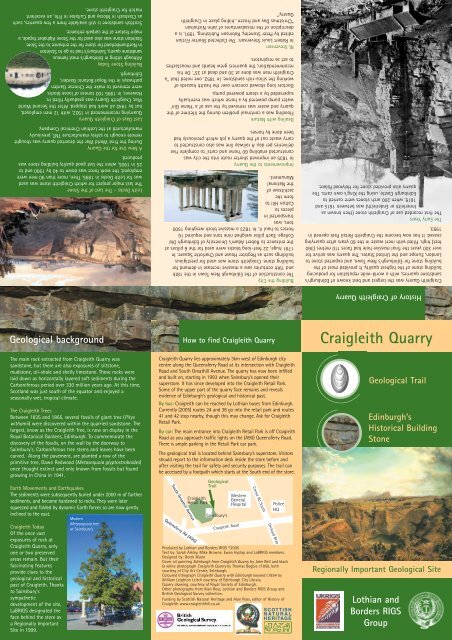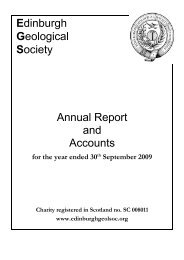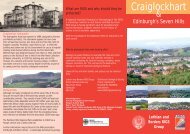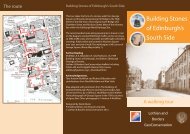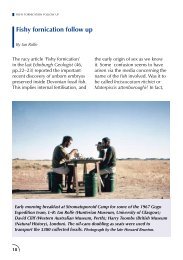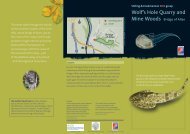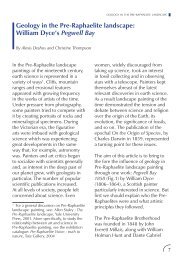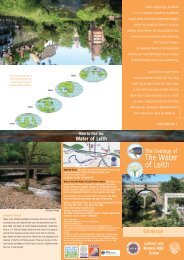Craigleith Quarry - Edinburgh Geological Society
Craigleith Quarry - Edinburgh Geological Society
Craigleith Quarry - Edinburgh Geological Society
Create successful ePaper yourself
Turn your PDF publications into a flip-book with our unique Google optimized e-Paper software.
History of <strong>Craigleith</strong> <strong>Quarry</strong><br />
<strong>Craigleith</strong> <strong>Quarry</strong> was the largest and best known of <strong>Edinburgh</strong>'s<br />
sandstone quarries, with a world-wide reputation for producing<br />
building stone of the highest quality. It provided most of the<br />
building stone for <strong>Edinburgh</strong>'s New Town, and exported stone to<br />
London, Europe and the United States. The quarry was active for<br />
over 300 years the final massive hole had faces 110 metres (360<br />
feet) high. Filled with inert waste in the 60 years after quarrying<br />
ceased. It has now become the <strong>Craigleith</strong> Retail Park opened in<br />
1993.<br />
The Early Years<br />
The first recorded use of <strong>Craigleith</strong> stone (then known as<br />
Innerleith or Enderleith) was between 1615 and<br />
1619, when 200 arch stones were carried to<br />
<strong>Edinburgh</strong> Castle, using the King's own carts. The<br />
quarry also provided stone for Holyrood Palace.<br />
Building the City<br />
The construction of the <strong>Edinburgh</strong> New Town in the 18th<br />
and 19th centuries saw a massive increase in demand for<br />
building stone. <strong>Craigleith</strong> stone was used for prestigious<br />
buildings such as Register House and Charlotte Square. In<br />
1791 huge, 22 feet-long blocks were used for the 6 pillars at<br />
the entrance to Robert Adam's University of <strong>Edinburgh</strong> Old<br />
College. Each pillar weighed nine tons and required 16<br />
horses to haul it. In 1823 a massive block weighing 1500<br />
tons, was<br />
transported in<br />
pieces to<br />
Calton Hill to<br />
form the<br />
architrave of<br />
the National<br />
Monument.<br />
Improvements to the <strong>Quarry</strong><br />
In 1835 an improved shorter route into the city was<br />
constructed enabling 60 ‘horse and carts’ to complete five<br />
deliveries per day. A railway line was also constructed to<br />
carry waste out of the quarry a job which previously had<br />
been done by horses.<br />
Dealing with Nature<br />
Flooding was a continual problem during the lifetime of the<br />
quarry and water was removed by the use of a ‘Horse Gin’<br />
water pump powered by a horse which was eventually<br />
superseded by a steam powered pump.<br />
Doctors long showed concern over the health hazards of<br />
working the silica-rich sandstone. In 1852, one noted that "a<br />
<strong>Craigleith</strong> man was done at 30 and dead at 35". On his<br />
recommendation, the quarriers grew beards and moustaches<br />
to act as respirators.<br />
RL Stevenson<br />
In Robert Louis Stevenson: The Collected Shorter Fiction<br />
edited by Peter Stoneley, Robinson Publishing, 1991, is a<br />
description of the misadventures of John Nicholson<br />
“Christmas Day and frozen...hiding place in <strong>Craigleith</strong><br />
<strong>Quarry</strong>.”<br />
Leith Docks – The Last of the Stone<br />
The last major project for which <strong>Craigleith</strong> stone was used<br />
was for Leith Docks in 1895. Then, more than 90 men were<br />
employed; the work force was down to 40 by 1900 and to<br />
25 in 1905, when the last good quality building stone was<br />
produced.<br />
A New Use for the <strong>Quarry</strong><br />
During the First World War the deserted quarry was thought<br />
remote enough to safely manufacture TNT, previously<br />
manufactured at the Lothian Chemical Company.<br />
Last Days of <strong>Craigleith</strong> <strong>Quarry</strong><br />
<strong>Quarry</strong>ing recommenced in 1922, with 12 men employed,<br />
but by 1942 all work had stopped. After the Second World<br />
War, <strong>Craigleith</strong> <strong>Quarry</strong> was gradually filled in.<br />
However, in 1995 100 tonnes of loose blocks<br />
were removed to make the Chinese Garden<br />
pathways in the Royal Botanic Garden,<br />
<strong>Edinburgh</strong>.<br />
Building Stone Today<br />
Although sitting in <strong>Edinburgh</strong>’s most famous<br />
sandstone quarry, Sainsbury’s had to go to Stainton<br />
in Northumberland for stone for the entrance to the Store.<br />
Stainton stone was also used for the Stone Alphabet façade, a<br />
major feature at the carpark entrance.<br />
Scottish sandstone is still available from a few quarries, such<br />
as Clashach in Moray and Cullaloe in Fife, an excellent<br />
match for <strong>Craigleith</strong> stone.<br />
<strong>Geological</strong> background<br />
The main rock extracted from <strong>Craigleith</strong> <strong>Quarry</strong> was<br />
sandstone, but there are also exposures of siltstone,<br />
mudstone, oil-shale and shelly limestone. These rocks were<br />
laid down as horizontally layered soft sediments during the<br />
Carboniferous period over 330 million years ago. At this time,<br />
Scotland was just south of the equator and enjoyed a<br />
seasonally wet, tropical climate.<br />
The <strong>Craigleith</strong> Trees<br />
Between 1835 and 1865, several fossils of giant tree (Pitys<br />
withamii) were discovered within the quarried sandstone. The<br />
largest, know as the <strong>Craigleith</strong> Tree, is now on display in the<br />
Royal Botanical Gardens, <strong>Edinburgh</strong>. To commemorate the<br />
discovery of the fossils, on the wall by the doorway to<br />
Sainsbury’s, Carboniferous tree stems and leaves have been<br />
carved. Along the pavement, are planted a row of the<br />
primitive tree, Dawn Redwood (Metasequoia glyptostroboides)<br />
once thought extinct and only known from fossils but found<br />
growing in China in 1941.<br />
Earth Movements and Earthquakes<br />
The sediments were subsequently buried under 2000 m of further<br />
sediments, and became hardened to rocks. They were later<br />
squeezed and folded by dynamic Earth forces so are now gently<br />
inclined to the east.<br />
<strong>Craigleith</strong> Today<br />
Of the once vast<br />
exposures of rock at<br />
<strong>Craigleith</strong> <strong>Quarry</strong>, only<br />
one or two preserved<br />
areas remain. But their<br />
fascinating features<br />
provide clues to the<br />
geological and historical<br />
past of <strong>Craigleith</strong>. Thanks<br />
to Sainsbury's<br />
sympathetic<br />
development of the site,<br />
LaBRIGS designated the<br />
face behind the store as<br />
a Regionally Important<br />
Site in 1999.<br />
Modern<br />
Metasequoia tree<br />
at Sainsbury’s<br />
How to find <strong>Craigleith</strong> <strong>Quarry</strong><br />
<strong>Craigleith</strong> <strong>Quarry</strong> lies approximately 3km west of <strong>Edinburgh</strong> city<br />
centre along the Queensferry Road at its intersection with <strong>Craigleith</strong><br />
Road and South Groathill Avenue. The quarry has now been infilled<br />
and built on, starting in 1993 when Sainsbury’s opened their<br />
superstore. It has since developed into the <strong>Craigleith</strong> Retail Park.<br />
Some of the upper part of the quarry face remains and reveals<br />
evidence of <strong>Edinburgh</strong>’s geological and historical past.<br />
By bus: <strong>Craigleith</strong> can be reached by Lothian buses from <strong>Edinburgh</strong>.<br />
Currently (2005) routes 24 and 38 go into the retail park and routes<br />
41 and 42 stop nearby, though this may change. Ask for <strong>Craigleith</strong><br />
Retail Park.<br />
By car: The main entrance into <strong>Craigleith</strong> Retail Park is off <strong>Craigleith</strong><br />
Road as you approach traffic lights on the (A90) Queensferry Road.<br />
There is ample parking in the Retail Park car park.<br />
The geological trail is located behind Sainsbury’s superstore. Visitors<br />
should report to the information desk inside the store before and<br />
after visiting the trail for safety and security purposes. The trail can<br />
be accessed by a footpath which starts at the South end of the store.<br />
<strong>Geological</strong><br />
Trail<br />
South Groathill Avenue<br />
Queensferry Rd (A90)<br />
<strong>Craigleith</strong><br />
Retail Park<br />
Sainsbury’s<br />
Western<br />
General<br />
Hospital<br />
<strong>Craigleith</strong> Road<br />
Crewe Rd South Orchard Brae<br />
Police<br />
HQ<br />
Produced by Lothian and Borders RIGS ©2005<br />
Text by: Sarah Arkley, Mike Browne, Ewan Hyslop and LaBRIGS members.<br />
Designed by: Derek Munn<br />
Cover oil painting <strong>Edinburgh</strong> from <strong>Craigleith</strong> <strong>Quarry</strong> by John Bell and black<br />
& white photograph <strong>Craigleith</strong> <strong>Quarry</strong> by Thomas Begbie c1850, both<br />
courtesy of City Art Centre, <strong>Edinburgh</strong>.<br />
Coloured lithograph <strong>Craigleith</strong> <strong>Quarry</strong> with <strong>Edinburgh</strong> beyond c1854 by<br />
William Leighton Leitch courtesy of <strong>Edinburgh</strong> City Library.<br />
<strong>Quarry</strong> drawing, courtesy of Royal <strong>Society</strong> of <strong>Edinburgh</strong>.<br />
Other photographs from Alan Ross, Lothian and Borders RIGS Group and<br />
British <strong>Geological</strong> Survey collection.<br />
Funding by Scottish Natural Heritage and Alan Ross, editor of History of<br />
<strong>Craigleith</strong> www.craigleithhill.co.uk<br />
SCOTTISH<br />
NATURAL<br />
HERITAGE<br />
<strong>Craigleith</strong> <strong>Quarry</strong><br />
<strong>Geological</strong> Trail<br />
<strong>Edinburgh</strong>’s<br />
Historical Building<br />
Stone<br />
Regionally Important <strong>Geological</strong> Site<br />
Lothian and<br />
Borders RIGS<br />
Group
<strong>Geological</strong> Trail<br />
The trail is along the cliff, the remains of the quarry<br />
face, situated immediately behind Sainsbury’s Superstore.<br />
Caution: Visitors should take care for their own safety,<br />
whether from the cliff, from any fallen material, or from<br />
operations within the retail park.<br />
Note: particularly that the trail does not extend to the<br />
part of the cliff past the bushes, which is the loading<br />
bay of the adjacent unit.<br />
This part of <strong>Craigleith</strong> <strong>Quarry</strong> is conserved as a RIGS. The<br />
use of hammers here is not permitted.<br />
First Impressions<br />
• The quarry face shows layers (beds) of sedimentary rock<br />
gently dipping down to the right (south-east).<br />
• The variation in colour and thickness of the beds suggests<br />
different rock types. The rock type is dependent on the<br />
environmental conditions which existed at the time the<br />
sediment was deposited.<br />
• The original soft sediments were laid down horizontally, but<br />
the hardened rocks were later tilted by dynamic Earth forces<br />
and are now inclined at 25 o to the south-east (right).<br />
• The oldest beds are located to the left, the overlying beds<br />
become progressively younger to the right.<br />
1 <strong>Craigleith</strong> Sandstone<br />
The rough sandy feel of this<br />
pale brown to grey rock and<br />
the individual grains of sand<br />
visible reveal the true nature<br />
of this sandstone.<br />
Under the microscope, almost<br />
all the sand grains are of the<br />
colourless mineral quartz. The<br />
quartz grains, about 0.25mm<br />
in size, are white in photo:<br />
the blue is a dye added to<br />
show spaces. Quartz is a<br />
strong and unreactive<br />
mineral, so the sandstone is<br />
very hard and durable, ideal<br />
properties for a building<br />
stone.<br />
The sandstone is made up of<br />
thick layers (beds) and<br />
contains natural vertical<br />
fractures (joints). The quarry<br />
men used these features to<br />
remove large blocks of<br />
building stone with simple<br />
tools.<br />
2 Fossil trees and sun-cracks<br />
Vertical cylindrical channels in the rock are Drill Marks<br />
cut to aid stone extraction. Within the sandstone beds<br />
traces of trees may be seen.<br />
Some fossil tree trunks excavated from <strong>Craigleith</strong><br />
<strong>Quarry</strong> can still be found, as this one in the Royal<br />
Botanic Gardens, <strong>Edinburgh</strong>.<br />
On the underside of an overhanging ledge of sandstone<br />
a network of thin ribs represent sun-cracks. These<br />
cracks formed as a result of the drying out of muddy<br />
puddles on lake shores, just as they do today. The cracks<br />
were later infilled by sand giving this polygonal<br />
network. The underlying mud hardened into mudstone, a<br />
dark grey crumbly rock.<br />
Ancient<br />
sun-cracks<br />
Modern<br />
sun-cracks<br />
1 2 3 4 5 6 7<br />
3 River channels and cross-bedding<br />
The sandstone has small beds at a steeper angle to the<br />
main bedding. This is cross-bedding, formed as sand moved<br />
across the bed of a river channel. This structure shows the<br />
direction the sediment was moving, here flowing towards<br />
the north.<br />
5 Shelly marine limestone<br />
Here the hard, crusty brown weathered limestone contains<br />
many marine shells visible in cross-section and in the<br />
round. The smooth-shelled, 1cm-across Schizodus,<br />
illustrated below, is most common. These deposits are<br />
evidence of flooding by<br />
the sea.<br />
4 Fossil burrows and plant material<br />
The fine-grained mudstones and siltstones here are<br />
noticeably thinly bedded and much darker in colour, due to<br />
the presence of organic matter such as plant fragments.<br />
Black coaly traces of fossil plants can be seen in the face<br />
and on fallen blocks. Other fossils found here are<br />
freshwater mussel shells, Naiadites, and feeding burrows<br />
known as Chondrites, pictured below, produced by worms<br />
living in the soft silty sediment. These suggest an<br />
environment of calmer water perhaps in a lake.<br />
6 Large-scale soft sedimentary deformation<br />
Within the pale sandstone beds pillow-like structures are<br />
seen. Most are several tens of cms to a metre in size, and<br />
are associated with dramatic folds and distortion. The<br />
underlying and overlying beds are not folded, so<br />
deformation likely occurred when the sediments were still<br />
soft and wet, possibly triggered by an earthquake. Shaking<br />
the wet sediment also forced water upwards creating small<br />
sand volcanoes.<br />
7 Oil-shale<br />
Overlying the<br />
limestone (at 5 )<br />
is a thick bed of<br />
black tough and<br />
papery mudstone.<br />
A brown streak when these mudstones are<br />
scratched with a knife indicates an unusually high organic<br />
content. Microscopic algae were abundant in the original<br />
muds resulting in algal rich mudstones known as oilshales.<br />
Oil products extracted from the shales formed the<br />
basis of the West Lothian oil industry which flourished<br />
during the late 19th and early 20th centuries.<br />
Changing environments<br />
Throughout the sedimentary sequence the variety of rock<br />
types and structures provide evidence for changing<br />
environments during the Carboniferous period. The area<br />
around <strong>Craigleith</strong> changed from one of large river systems<br />
and deltas with tropical swamps, to lakes and a shallow<br />
sea. Each of these environments has left its own<br />
geological signature in the rock record. It is important that<br />
RIGS sites like <strong>Craigleith</strong> are looked after and preserved for<br />
others to enjoy and learn from.


